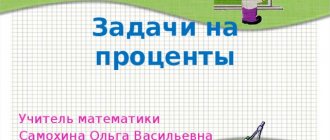Mathematics is a science that can only be learned through hard work. While studying a mathematics course in the 8th grade, schoolchildren get acquainted with such interesting sections as solving quadratic equations and composing such equations for solving problems, solving fractional rational equations, and many others. etc.
Students can deepen and systematize the knowledge acquired in the lessons only by solving practical tasks, completing independent work and tests, and participating in mathematics Olympiads.
The website contains Olympiad tasks in mathematics with answers and solutions. When preparing for the Olympiad, you can use the examples of equations, problems and mathematical riddles presented on this page.
- Equations
- Tasks
- Math riddles
- Answers to equations
- Answers to problems
- Answers to riddles
Mathematics Olympiad 8th grade
Download the assignments by filling out the form!
After you provide the data, the download button will become active.
Tasks
Task No. 1 The employee entered into a contract for a month on the following terms. For each day worked he receives 100 rubles. If he is absent, he not only receives nothing, but is subject to a fine of 25 rubles for each day of absenteeism. After 30 days it turned out that the employee had earned nothing. How many days did he actually work?
Task No. 2 Doctor Aibolit distributed 2006 miraculous tablets to four sick animals. The rhinoceros received one more than the crocodile, the hippopotamus received one more than the rhinoceros, and the elephant received one more than the hippopotamus. How many tablets will the elephant have to eat?
Problem No. 3 Three friends each made one statement about the integer x
.
Petya: “The number x
is more than 4, but less than 8.”
Vasya: “The number x
is more than 6, but less than 9.”
Tolya: “The number x
is more than 5, but less than 8.” Find the number x if it is known that two of the friends told the truth and the third lied. It is necessary not only to check that the number found is suitable, but also to explain why other answer options are impossible.
Problem No. 4 The lake contains crucian carp, perch and pike. Two fishermen caught 70 fish together, with the first fisherman’s catch being crucian carp and the second’s catch being perch. How many pikes did each catch if both caught equal amounts of crucian carp and perch?
Problem No. 5 Three men came to the hairdresser. Having shaved the first one, he said: “Look how much money is in the desk drawer, put the same amount and take 2 dollars in change.” He also said the same to the second and third. When they left, it turned out that there was no money in the box. How much money was in the box initially if everyone managed to accomplish their plans?
Methods for solving quadratic equations
Our project is about ways to solve quadratic equations. Goal of the project: learn to solve quadratic equations in ways not included in the school curriculum. Task: find all possible ways to solve quadratic equations and learn how to use them yourself and introduce these methods to your classmates.
What are “quadratic equations”?
A quadratic equation is an equation of the form ax 2 + bx + c = 0 , where a , b , c are some numbers ( a ≠ 0 ), x is an unknown.
The numbers a, b, c are called the coefficients of the quadratic equation.
- a is called the first coefficient;
- b is called the second coefficient;
- c is a free member.
Who was the first to “invent” quadratic equations?
Some algebraic techniques for solving linear and quadratic equations were known 4000 years ago in Ancient Babylon. The discovery of ancient Babylonian clay tablets, dating from somewhere between 1800 and 1600 BC, provides the earliest evidence of the study of quadratic equations. The same tablets contain methods for solving certain types of quadratic equations.
The need to solve equations not only of the first, but also of the second degree, even in ancient times, was caused by the need to solve problems related to finding the areas of land plots and with excavation work of a military nature, as well as with the development of astronomy and mathematics itself.
The rule for solving these equations, set out in the Babylonian texts, essentially coincides with the modern one, but it is not known how the Babylonians arrived at this rule. Almost all cuneiform texts found so far provide only problems with solutions laid out in the form of recipes, with no indication as to how they were found. Despite the high level of development of algebra in Babylon, the cuneiform texts lack the concept of a negative number and general methods for solving quadratic equations.
Babylonian mathematicians from about the 4th century BC. used the square's complement method to solve equations with positive roots. Around 300 BC Euclid came up with a more general geometric solution method. The first mathematician who found solutions to equations with negative roots in the form of an algebraic formula was the Indian scientist Brahmagupta (India, 7th century AD).
Brahmagupta laid out a general rule for solving quadratic equations reduced to a single canonical form:
ax2 + bx = c, a>0
The coefficients in this equation can also be negative. Brahmagupta's rule is essentially the same as ours.
Public competitions in solving difficult problems were common in India. One of the old Indian books says the following about such competitions: “As the sun outshines the stars with its brilliance, so a learned man will outshine his glory in public assemblies by proposing and solving algebraic problems.” Problems were often presented in poetic form.
Al-Khwarizmi's algebraic treatise gives a classification of linear and quadratic equations. The author counts 6 types of equations, expressing them as follows:
1) “Squares are equal to roots,” i.e. ax2 = bx.
2) “Squares are equal to numbers,” i.e. ax2 = c.
3) “The roots are equal to the number,” i.e. ax2 = c.
4) “Squares and numbers are equal to roots,” i.e. ax2 + c = bx.
5) “Squares and roots are equal to the number,” i.e. ax2 + bx = c.
6) “Roots and numbers are equal to squares,” i.e. bx + c == ax2.
For Al-Khwarizmi, who avoided the use of negative numbers, the terms of each of these equations are addends and not subtractables. In this case, equations that do not have positive solutions are obviously not taken into account. The author sets out methods for solving these equations using the techniques of al-jabr and al-mukabal. His decision, of course, does not completely coincide with ours. Not to mention that it is purely rhetorical, it should be noted, for example, that when solving an incomplete quadratic equation of the first type, Al-Khorezmi, like all mathematicians until the 17th century, does not take into account the zero solution, probably because in specific practical it doesn't matter in tasks. When solving complete quadratic equations, Al-Khwarizmi sets out the rules for solving them using particular numerical examples, and then their geometric proofs.
Forms for solving quadratic equations following the model of Al-Khwarizmi in Europe were first set forth in the “Book of the Abacus,” written in 1202. Italian mathematician Leonard Fibonacci. The author independently developed some new algebraic examples of solving problems and was the first in Europe to approach the introduction of negative numbers.
This book contributed to the spread of algebraic knowledge not only in Italy, but also in Germany, France and other European countries. Many problems from this book were used in almost all European textbooks of the 14th-17th centuries. The general rule for solving quadratic equations reduced to a single canonical form x2 + bх = с for all possible combinations of signs and coefficients b, c was formulated in Europe in 1544 by M. Stiefel.
The derivation of the formula for solving a quadratic equation in general form is available from Viète, but Viète recognized only positive roots. Italian mathematicians Tartaglia, Cardano, Bombelli were among the first in the 16th century. In addition to positive ones, negative roots are also taken into account. Only in the 17th century. Thanks to the works of Girard, Descartes, Newton and other scientists, the method of solving quadratic equations takes on a modern form.
Let's look at several ways to solve quadratic equations.
Standard methods for solving quadratic equations from the school curriculum:
- Factoring the left side of the equation.
- Method for selecting a complete square.
- Solving quadratic equations using the formula.
- Graphical solution of a quadratic equation.
- Solving equations using Vieta's theorem.
Let us dwell in more detail on the solution of reduced and unreduced quadratic equations using Vieta’s theorem.
Recall that to solve the above quadratic equations, it is enough to find two numbers whose product is equal to the free term, and whose sum is equal to the second coefficient with the opposite sign.
Example. x 2 -5x+6=0
You need to find numbers whose product is 6 and whose sum is 5. These numbers will be 3 and 2.
Answer: x 1 =2, x 2 =3.
But you can also use this method for equations with the first coefficient not equal to one.
Example. 3x 2 +2x-5=0
Take the first coefficient and multiply it by the free term: x2+2x-15=0
The roots of this equation will be numbers whose product is equal to - 15, and whose sum is equal to - 2. These numbers are 5 and 3. To find the roots of the original equation, divide the resulting roots by the first coefficient.
Answer: x 1 =-5/3, x 2 =1
6. Solving equations using the “throwing” method.
Consider the quadratic equation ax2 + bx + c = 0, where a≠0.
Multiplying both sides by a, we obtain the equation a2x2 + abx + ac = 0.
Let ax = y, whence x = y/a; then we arrive at the equation y2 + by + ac = 0, which is equivalent to the given one. We find its roots y1 and y2 using Vieta’s theorem.
We finally get x1 = y1/a and x2 = y2/a.
With this method, the coefficient a is multiplied by the free term, as if “thrown” to it, therefore it is called the “throw” method. This method is used when the roots of the equation can be easily found using Vieta's theorem and, most importantly, when the discriminant is an exact square.
Example. 2x 2 - 11x + 15 = 0.
Let’s “throw” the coefficient 2 to the free term and make a substitution and get the equation y2 - 11y + 30 = 0.
According to Vieta's inverse theorem
y1 = 5, x1 = 5/2, x1=2.5;y2 = 6, x2 = 6/2, x2 = 3.
Answer: x 1 =2.5; x 2 = 3.
7. Properties of coefficients of a quadratic equation.
Let the quadratic equation ax2 + bx + c = 0, a ≠ 0 be given.
1. If a+ b + c = 0 (i.e. the sum of the coefficients of the equation is zero), then x1 = 1.
2. If a - b + c = 0, or b = a + c, then x1 = - 1.
Example. 345x 2 - 137x - 208 = 0.
Since a + b + c = 0 (345 - 137 - 208 = 0), then x1 = 1, x2 = -208/345.
Answer: x 1 =1; x 2 = -208/345 .
Example. 132x 2 + 247x + 115 = 0
Because a-b+c = 0 (132 - 247 +115=0), then x1= - 1, x2= - 115/132
Answer: x 1 = - 1; x 2 = - 115/132
There are other properties of the coefficients of a quadratic equation. but their use is more complex.
8. Solving quadratic equations using a nomogram.
Fig 1. Nomogram
This is an old and currently forgotten method of solving quadratic equations, placed on p. 83 of the collection: Bradis V.M. Four-digit math tables. - M., Education, 1990.
Table XXII. Nomogram for solving the equation z2 + pz + q = 0. This nomogram allows, without solving the quadratic equation, to determine the roots of the equation from its coefficients.
The curvilinear scale of the nomogram is built according to the formulas (Fig. 1):
OB =AB =
Assuming OS = p, ED = q, OE = a (all in cm), from Fig. 1 of the similarity of triangles SAN and CDF we obtain the proportion
from which, after substitutions and simplifications, the equation z2 + pz + q = 0 follows, and the letter z means the label of any point on the curvilinear scale.
Rice. 2 Solving quadratic equations using a nomogram
Examples.
1) For the equation z 2 - 9z + 8 = 0 , the nomogram gives the roots z1 = 8.0 and z2 = 1.0
Answer:8.0; 1.0.
2) Using a nomogram, we solve the equation
2z 2 - 9z + 2 = 0.
Let's divide the coefficients of this equation by 2, we get the equation z2 - 4.5z + 1 = 0.
The nomogram gives roots z1 = 4 and z2 = 0.5.
Answer: 4; 0.5.
9. Geometric method for solving quadratic equations.
Example. x 2 + 10x = 39.
In the original, this problem is formulated as follows: “The square and ten roots are equal to 39.”
Consider a square with side x, rectangles are constructed on its sides so that the other side of each of them is 2.5, therefore the area of each is 2.5x. The resulting figure is then supplemented to a new square ABCD, building four equal squares in the corners, the side of each of them is 2.5, and the area is 6.25
Rice. 3 Graphical method for solving the equation x2 + 10x = 39
The area S of square ABCD can be represented as the sum of the areas of: the original square x2, four rectangles (4∙2.5x = 10x) and four additional squares (6.25∙4 = 25), i.e. S = x2 + 10x = 25. Replacing x2 + 10x with the number 39, we get that S = 39+ 25 = 64, which means that the side of the square is ABCD, i.e. segment AB = 8. For the required side x of the original square we obtain
10. Solving equations using Bezout's theorem.
Bezout's theorem. The remainder of dividing the polynomial P(x) by the binomial x - α is equal to P(α) (that is, the value of P(x) at x = α).
If the number α is the root of the polynomial P(x), then this polynomial is divisible by x -α without a remainder.
Example. x²-4x+3=0
Р(x)= x²-4x+3, α: ±1,±3, α =1, 1-4+3=0. Divide P(x) by (x-1): (x²-4x+3)/(x-1)=x-3
x²-4x+3=(x-1)(x-3), (x-1)(x-3)=0
x-1=0; x=1, or x-3=0, x=3; Answer: x 1 =2, x 2 =3.
Conclusion: The ability to quickly and rationally solve quadratic equations is simply necessary for solving more complex equations, for example, fractional-rational equations, equations of higher powers, biquadratic equations, and in high school, trigonometric, exponential and logarithmic equations. Having studied all the found methods for solving quadratic equations, we can advise our classmates, in addition to the standard methods, to solve by the transfer method (6) and solve equations using the property of coefficients (7), since they are more accessible to understanding.
Literature:
- Bradis V.M. Four-digit math tables. - M., Education, 1990.
- Algebra 8th grade: textbook for 8th grade. general education institutions Makarychev Yu. N., Mindyuk N. G., Neshkov K. I., Suvorova S. B. ed. S. A. Telyakovsky 15th ed., revised. — M.: Education, 2015
- https://ru.wikipedia.org/wiki/%D0%9A%D0%B2%D0%B0%D0%B4%D1%80%D0%B0%D1%82%D0%BD%D0%BE%D0 %B5_%D1%83%D1%80%D0%B0%D0%B2%D0%BD%D0%B5%D0%BD%D0%B8%D0%B5
- Glazer G.I. History of mathematics at school. Manual for teachers. / Ed. V.N. Younger. - M.: Education, 1964.







